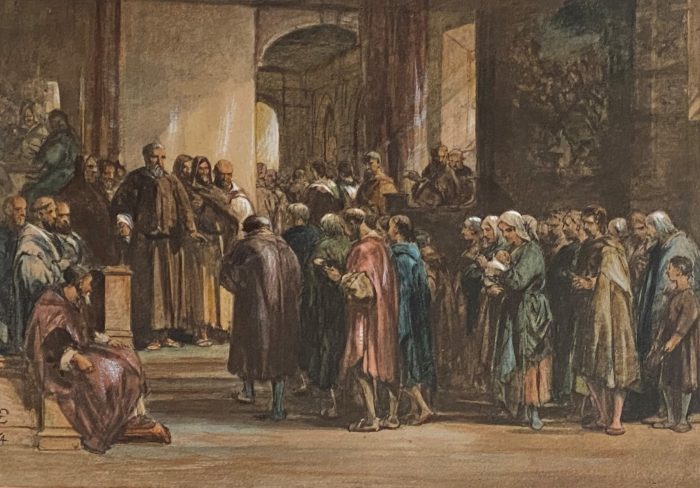One living a monastic life embarks on a path of spiritual exploration and self-discovery. This immersive narrative delves into the daily routines, rituals, and relationships that shape the monastic experience, shedding light on its profound impact on individuals and communities.
From the solitude of meditation to the shared rituals of prayer and work, monastic life offers a unique perspective on the nature of existence. Within monastic communities, individuals navigate vows of silence and obedience, forging deep connections while exploring the depths of their own spirituality.
Daily Routine and Practices

The daily schedule of a monastic life is typically structured around a set of practices and rituals designed to foster spiritual growth and inner transformation.
Monastics typically rise early, before dawn, and begin their day with meditation and prayer. These practices help to center the mind and cultivate a sense of inner stillness. After meditation, monastics often engage in communal prayers or chanting, which serve to connect them with their spiritual community and strengthen their sense of belonging.
Work and Service
In addition to spiritual practices, monastics also engage in various forms of work and service. This may include manual labor, such as farming or gardening, as well as intellectual pursuits, such as studying religious texts or writing. Work is seen as a form of spiritual practice, as it provides an opportunity to cultivate virtues such as humility, patience, and diligence.
Significance of Practices
The various practices and rituals of monastic life are designed to support the monastic’s spiritual journey. Meditation and prayer help to cultivate inner peace and stillness, while work and service provide opportunities to practice virtues and develop a sense of compassion for others.
By engaging in these practices, monastics seek to deepen their connection with the divine, cultivate a life of simplicity and non-attachment, and ultimately achieve spiritual liberation.
Monastic Community and Relationships

A monastic community is a group of people who live together in a monastery or convent, following a set of religious rules and practices. The structure and organization of a monastic community can vary depending on the religious tradition and the specific monastery or convent.
However, there are some common features that are found in many monastic communities.
One of the most important aspects of a monastic community is the vow of obedience. Monks and nuns promise to obey the abbot or abbess, who is the leader of the community. This vow of obedience is seen as a way to show humility and to put the needs of the community above one’s own desires.
Roles and Responsibilities
The abbot or abbess is responsible for the spiritual and temporal welfare of the community. They lead the monks and nuns in prayer, study, and work. The abbot or abbess is also responsible for making decisions about the community, such as admitting new members and setting the rules for the community.
In addition to the abbot or abbess, there are often other leaders in a monastic community. These leaders may include the prior, who is second in command to the abbot or abbess, and the cellarer, who is responsible for the monastery’s finances and supplies.
Monks and nuns in a monastic community typically live a simple life, dedicated to prayer, study, and work. They may spend their days working in the monastery’s fields or workshops, or they may spend their time studying religious texts. Monks and nuns also typically take vows of poverty, chastity, and obedience.
Dynamics and Relationships
The dynamics and relationships within a monastic community can be complex. Monks and nuns come from all walks of life, and they bring their own unique experiences and perspectives to the community. This can lead to both challenges and opportunities for growth.
One of the challenges of living in a monastic community is the vow of silence. Monks and nuns often take vows of silence, which means that they are not allowed to speak to each other except in certain circumstances. This vow of silence can be difficult to maintain, but it can also be a powerful way to learn to listen to God and to one another.
For those living a monastic life, tranquility and self-reflection are paramount. However, even in the serene confines of a monastery, crisis plans should be robust . Emergencies can arise unexpectedly, and being prepared can ensure the safety and well-being of the monastic community.
As one who seeks spiritual enlightenment, it is equally important to maintain a practical approach, ensuring that the path to enlightenment is not hindered by unforeseen circumstances.
Despite the challenges, monastic communities can be places of great peace and joy. Monks and nuns who live in monastic communities often find that they develop deep and lasting relationships with one another. These relationships are based on a shared commitment to God and to the monastic life.
Purpose and Meaning in Monastic Life

The motivations for choosing a monastic life vary greatly, but at the core lies a profound desire for spiritual growth and connection with the divine. Monasticism offers a path to inner transformation and a deeper understanding of one’s purpose in life.
Individuals may seek refuge in monasticism for various reasons. Some are drawn to the promise of a simpler and more meaningful existence, free from the distractions of the secular world. Others may seek solace from personal suffering or a sense of emptiness within.
Regardless of their initial motivations, monastics find solace and purpose in a life dedicated to contemplation, prayer, and service.
Spiritual Benefits
Monasticism provides a fertile ground for spiritual development. Through daily rituals, meditation, and study of sacred texts, monastics cultivate a deep connection with the divine. They seek to purify their minds and hearts, fostering a state of inner peace and serenity.
The monastic environment encourages self-reflection and introspection, allowing individuals to confront their inner demons and embrace their true nature.
Psychological and Emotional Benefits
In addition to its spiritual benefits, monasticism can also have profound psychological and emotional effects. The structured routine and communal living provide a sense of stability and belonging. Monastics learn to manage their emotions, develop resilience, and cultivate compassion for themselves and others.
The practice of detachment and renunciation helps them overcome attachments and find contentment in simplicity.
Concept of Renunciation and Detachment
At the heart of monasticism lies the concept of renunciation and detachment. Monastics renounce worldly possessions, relationships, and desires in order to focus their lives on the pursuit of spiritual enlightenment. They practice detachment from material objects and external circumstances, seeking to find fulfillment within themselves and their connection to the divine.
This process of letting go can be challenging, but it ultimately leads to a greater sense of freedom and inner peace.
Challenges and Rewards

Monastic life presents unique challenges that test the limits of one’s faith and commitment. These challenges, however, can also serve as catalysts for profound spiritual growth and personal transformation.
Obstacles and Difficulties
- Isolation and Solitude:Monastic life often involves extended periods of isolation and solitude, which can be emotionally and mentally demanding.
- Celibacy and Chastity:The vow of celibacy requires the renunciation of physical intimacy, which can be a significant challenge for those accustomed to worldly relationships.
- Asceticism and Discipline:Monastic life emphasizes simplicity, austerity, and strict adherence to rules and regulations, which can be physically and emotionally taxing.
- Temptations and Distractions:Monastic communities are not immune to temptations and distractions, which can test the resolve of even the most devoted individuals.
Rewards and Spiritual Growth
Despite the challenges, monastic life offers numerous rewards and opportunities for spiritual growth:
- Deepening Relationship with God:The isolation and solitude of monastic life allow for extended periods of contemplation and prayer, fostering a closer relationship with the divine.
- Personal Transformation:The challenges and discipline of monastic life can lead to significant personal transformation, cultivating virtues such as humility, patience, and compassion.
- Enlightenment and Liberation:The ultimate goal of monastic life is to achieve enlightenment or liberation from the cycle of suffering and rebirth, which can be realized through meditation, spiritual practices, and the guidance of a teacher.
Examples of Transformation
Throughout history, countless individuals have embarked on monastic paths and experienced profound personal transformations:
- The Buddha:Siddhartha Gautama renounced his royal life to pursue a path of enlightenment, eventually becoming the Buddha and founding Buddhism.
- Saint Francis of Assisi:The Italian monk and mystic embraced poverty and simplicity, inspiring a movement of followers known as the Franciscans.
- Thich Nhat Hanh:The Vietnamese Zen master and peace activist taught the importance of mindfulness and compassion, promoting peace and understanding worldwide.
These examples demonstrate that monastic life can be a powerful path to personal transformation and enlightenment, offering a unique opportunity for individuals to transcend their limitations and realize their spiritual potential.
Historical and Cultural Context

Monasticism, the practice of withdrawing from society to live a life of religious devotion, has a rich and diverse history across different cultures and religions.
The earliest forms of monasticism emerged in ancient India, where ascetics sought spiritual enlightenment through meditation and self-denial. In the 6th century BCE, the Buddha established the first monastic order, the Sangha, which played a pivotal role in the spread of Buddhism throughout Asia.
Influence on Society, Art, and Literature
Monasticism has had a profound influence on the development of human civilization. Monasteries served as centers of learning and scholarship, preserving and transmitting knowledge during periods of social and political upheaval.
Monks and nuns made significant contributions to art and literature. They illuminated manuscripts, composed music, and wrote theological treatises that shaped religious and philosophical thought.
Contemporary Relevance and Significance, One living a monastic life
In the modern world, monastic life continues to hold relevance and significance. Monasteries provide a refuge from the complexities of modern society, offering a space for contemplation, spiritual growth, and service to others.
Contemporary monastic communities are adapting to the changing needs of the 21st century, engaging in social justice initiatives, interfaith dialogue, and environmental stewardship.
Frequently Asked Questions: One Living A Monastic Life
What is the purpose of monastic life?
Monastic life provides a structured environment for individuals to focus on spiritual growth, contemplation, and service.
What are the typical daily practices of monastic life?
Daily practices may include meditation, prayer, work, study, and communal meals.
What is the role of the abbot in a monastic community?
The abbot is the spiritual leader and head of the community, responsible for its overall guidance and well-being.
